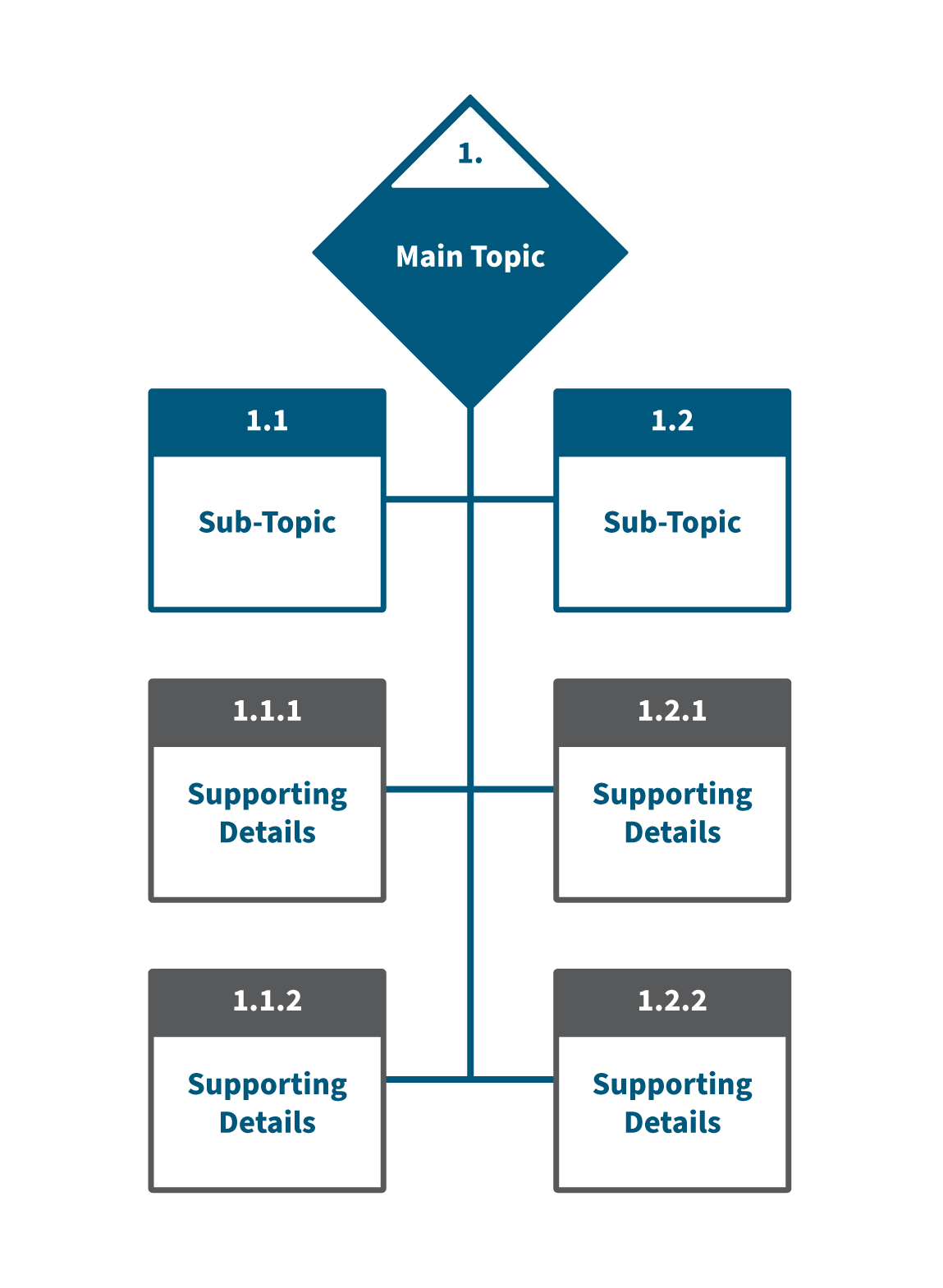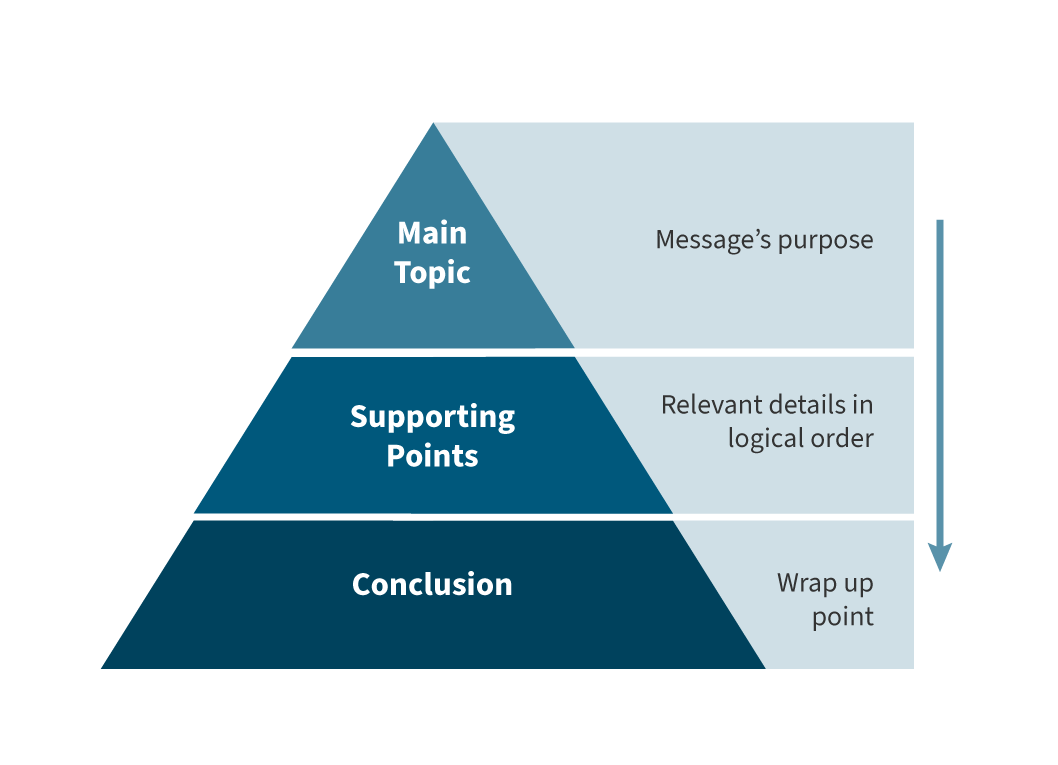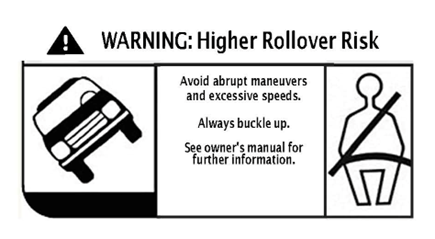Formatting Strategies
These formatting tips will help your content flow logically and make information quick and easy to understand.
All information is created for an audience. So, you need to organize all details in the order your audience needs to know them. For example, share your purpose at the beginning of your content. Make sure you answer for your audience, Why should I care about this information?
When planning to organize your information, ask yourself questions like:
- What is the main topic I am sharing (purpose)?
- What information does my audience need to know first? Second? Third?
- What supporting details do they need to know to understand the message?
- When and what calls to action do they need to follow?
Information hierarchy organizes information by what’s most important for the reader to know first.
Outline and organize information for logical, chronological flow. Your calls to action will usually be at the beginning where you share your main topic (purpose). For longer content, you can also restate your calls to action later in the content. Repeat this structure for each new paragraph and each document.


Creating content that works across webpages, printed manuals, FAQs, and more can feel overwhelming. It’s easy to get stuck deciding what goes where and when to update each version.
The key? Focus on your audience. Organize your content so it’s clear, helpful, and tailored to their needs. No matter how they access it.
Do
- Update content as soon as possible. Whether it’s on paper, in an IVR, or online, adapt it to fit the communication channel. Each version should meet your audience where they are, even if it’s not identical or updated all at once.
- Prioritize clarity. Every format should be easy to understand, whether someone is reading a printed manual or browsing our website.
Don’t
- Copy-paste from your main webpage. Each format serves a different purpose, so tailor the content instead of repeating it.
- Use FAQs to explain everything. It’s not a band aid to fix all customer issues. FAQs should answer quick questions not already covered in the main content. It should not define terms or walk through entire processes.
Keep your audience in mind, and your content will work harder for them!
Long, dense blocks of texts are difficult to read. People will see a wall of content and won’t read it. You can encourage an easier reading experience by using headers and subheadings.
Using headers helps audiences:
- Have content chunks that encourage white space.
- Skim and scan information quickly.
- Transition between sections.
- Predict information that’s ahead.
Create headings and subheadings purposefully.
- Headings describe a section’s main topic. Use a font size that’s larger than your body copy.
- Subheadings support the main section and describe its content. Use a font size that’s smaller than the main headers.
Use parallel structure in your headings and subheadings. All headings should follow the same pattern. All subheadings should also use the same pattern.
Heading Types
You have different heading types to use depending on how you want your headers to work.
| Heading Type | Purpose | Example |
|---|---|---|
| Topic | Provides only the topic detail, often serves as the document’s main header. | Prove Your Identity |
| Descriptive | Has more description that brings energy and invites the reader into the topic. | Prove Your Identity: How to Submit Documents |
| Question | Frames topic as questions your audience would ask, usually in complete sentences. | How do you submit documents to prove your identity? |
Title Case or Sentence Case
Use title case or sentence case. Pick one based on what you think is best for your audience. When you do, commit to the style relationship! Pick one style for the entirety of your product.
When in doubt, default to title case.
When you do, capitalize
- Short verb forms like Is, Be, I’m, He’s
- Conjunctions of four or more letters: Because, While, Since, Though
- Prepositions of five or more letters: Within, About, Among, Between
Do not capitalize
- Articles: a, an, the
- Conjunctions fewer than four letters: and, as, but, if, or, nor
- Prepositions fewer than four letters: at, by, for, in, of, off, on, out, to, up
Exceptions: The first and last word of a title should be capitalized regardless of the category.
A Home to Be Proud Of
Example
With just adding in headers and reorganizing information.
| Before | After |
|---|---|
|
Excerpt from National Center for Science and Governing Statistics An FFRDC meets some special long-term research or development need which cannot be met as effectively by existing in-house or contractor resources. FFRDCs enable agencies to use private sector resources to accomplish tasks that are integral to the mission and operation of the sponsoring agency. An FFRDC, in order to discharge its responsibilities to the sponsoring agency, has access, beyond that which is common to the normal contractual relationship, to Government and supplier data, including sensitive and proprietary data, and to employees and installations equipment and real property. The FFRDC is required to conduct its business in a manner befitting its special relationship with the Government, to operate in the public interest with objectivity and independence, to be free from organizational conflicts of interest, and to have full disclosure of its affairs to the sponsoring agency. It is not the Government's intent that an FFRDC use its privileged information or access to installations equipment and real property to compete with the private sector. However, an FFRDC may perform work for other than the sponsoring agency under the Economy Act, or other applicable legislation, when the work is not otherwise available from the private sector. Source: National Center for Science and Engineering Statistics |
What is an FFRDC? An FFRDC meets some special long-term research or development need which cannot be met as effectively by existing in-house or contractor resources. FFRDCs enable agencies to use private sector resources to accomplish tasks that are integral to the mission and operation of the sponsoring agency. Operational Requirements The FFRDC is required to:
Information Access An FFRDC, in order to discharge its responsibilities to the sponsoring agency, has access, beyond that which is common to the normal contractual relationship, to Government and supplier data, including sensitive and proprietary data, and to employees and installations equipment and real property. Competing With Private Sector It is not the Government's intent that an FFRDC use its privileged information or access to installations equipment and real property to compete with the private sector. However, an FFRDC may perform work for other than the sponsoring agency under the Economy Act, or other applicable legislation, when the work is not otherwise available from the private sector. |
In the before example, the message is hard to follow because there’s too much text at once. It feels overwhelming. Many people might stop reading after the first couple of sentences.
By adding headings and subheadings, the content becomes easier to read. White space gives the text room to breathe and makes it easier on the eyes. Headings also help readers quickly understand what each section is about. Even if they only skim, they’ll still get the main points of the information.
It’s tempting to overdo it when highlighting something important. We get it! But too much emphasis can make your content harder to read. Keep it simple and clear.
- Bold- Use sparingly for key points like Note or Important. For digital use, bold button names like Yes, No, or to select Next.
- Italics- Use only for the first introduction of a new term or concept, like a glossary term.
- Quotes- Save these for direct quotes when “only this exact wording here” can be used.
Don’t Do
Click Yes. Enter “EDD” as the agency name in the Comments section.
Do
Select Yes. Enter “EDD” as the agency name in the Comments section.
Creating lists that live within sentences and have a lot of phrases, commas, and semicolons easily confuse audiences. The sentences are typically too long and can hide important details within the body of text. Quickly understanding how information relates becomes challenging. By listing these words or phrases with bullets or numbers, you make the information scannable and easier to see and act on.
Use bullets when
- Items are equal value.
- Details are not sequential or chronological.
- Items are in alphabetical order.
Use numbers when
- The priority of items matters.
- Details are sequential or chronological.
- The count of items matters (and you introduce that number in intro clause).
Avoid Listing
Avoid listing whole paragraphs simply to do so. These bullet points do not convey any meaning to the reader and make the content more difficult to follow. Only use bullets when sharing listed items.
Example
| Before | After |
|---|---|
|
From EDD’s Displaced Oil and Gas Workers Fund Evaluation and Technical Assistance, Program Year 2023-24 Solicitation for Proposals The EDD will contact the awardee to negotiate and finalize contract details. The EDD may request that the contracts incorporate changes to the original project proposals. After the contract is finalized, the awardee will officially enter a contract with the EDD to provide the services listed in the contract for the amount awarded. Any unauthorized deviation or non-responsiveness may be grounds for breach of contract with legal repercussions. Please ensure that the contract goals and objectives are feasible and reasonable for your organization and that your infrastructure supports the administrative and operational requirements. The state expects contract negotiations to begin immediately after providing official award notices. A Notice of Award does not automatically entitle the grantee to funding. The EDD reserves the right to terminate any funding offer if a grantee does not negotiate in good faith. Awardees are advised to consider whether official action by a County Board of Supervisors, City Council, or other similar decision-making body will be necessary before accepting funds awarded under this SFP. The time needed for such an official action will affect the grantee’s ability to meet the project terms and conditions and the projected work plan. |
D. How do we manage awarding a contract? We will contact the awardee to negotiate and finalize contract details. We will use the following process with you:
Please note: We can choose to cancel any funding if we believe an awardee does not negotiate in good faith.
Please note: Plan this request wisely in the contract process. The time you may need for that request will affect your ability to meet the projected work plan’s project terms and conditions.
Be aware: If you do not communicate with us or make any unauthorized changes, we can consider it a breach of contract. We can take legal percussions as a result. |
In the before example:
The grade level is 13.9. So, a person needs to be in college to possibly understand this content. But the dense block of text and difficult wording is still challenging to get through. With no formatting, audiences are hit with dense text that doesn’t use clear formatting or helpful headers.
In the after example:
- Grade level decreases to 9.6.
- Content is much easier to skim and scan. Added headings and bullet points tell people what the details are about.
- The numbered list takes readers through the process of rewarding a contract.
- White space and formatting let the content breathe. Makes the content quicker to understand.
- Content speaks directly to the audience with a you voice. Creates an engaging conversation between EDD and the audience.
- Jargon and difficult language become simpler wording.
Using pictures or charts makes your content more fun and easier to remember. They split up the words, keep people interested, and help them understand the information easier.
Visuals
- Charts
- Graphs
- Illustrations
- Images
- Tables
- And more!
Turn text-heavy or data driven content into visual communication.
Examples
| Before | After | |||||||||||||||
|---|---|---|---|---|---|---|---|---|---|---|---|---|---|---|---|---|
|
Dense Text
Source: Plainlanguage.gov |
§ 163.25 Will BIA withhold any forest management deductions? We will withhold a forest management deduction if the contract for the sale of forest products has a value of over $5,000. The deduction will be a percentage of the price we get from the buyer. The following table shows how we determine the amount of the deduction.
|
|||||||||||||||
|
Request for Identity Verification (DE 1326C) You have two options to submit your verification documents:
Important: Include your complete Social Security number on ALL documents mailed. |
How You Can Submit Documents You have two ways to submit documents:
|
|||||||||||||||
|
This is a multipurpose passenger vehicle which will handle and maneuver differently from an ordinary passenger car, in driving conditions which may occur on streets and highways and off road. As with other vehicles of this type, if you make sharp turns or abrupt maneuvers, the vehicle may roll over or may go out of control and crash. You should read driving guidelines and instructions in the Owner’s Manual, and WEAR YOUR SEAT BELTS AT ALL TIMES. Source: Plainlanguage.gov |
 |
The Department style when referencing a form or publication in a sentence is to italicize the title, followed by the form number in parentheses.
The Quarterly Contribution Return and Report of Wages (DE 9) must be submitted electronically.
Spell out the form title followed by the form number in first reference. You can use just the form number in the rest of the document.
When forms are hyperlinked to a downloadable file, include the file type in the link label.
The California Training Benefits (DE 8714U) (PDF) fact sheet has more information on various types of training programs available.
The Forms Governance Policy and Process (EN 19-01) (PDF) ensures that uniform design and content standards are applied to all EDD forms and publications.
Do not italicize the form number or the file type.
When referencing an executive notice, italicize the subject, followed by the executive notice number in parentheses.
Link text refers to any text within a document, webpage, or email that links readers to another page, place in the document, webpage or online resource. Creating meaningful link text allows readers to understand where the link leads before selecting it. Questions about formatting online? Check out the Web Development Standards or ask the Web Content team.
| Type | Black and White Document | Color Document | Best Practices |
|---|---|---|---|
| Print Only |
Visit edd.ca.gov/Unemployment. Contact DIB at DIBOutreach@edd.ca.gov. Learn about Paid Family Leave at edd.ca.gov/PaidFamilyLeave. |
Visit edd.ca.gov/Unemployment. Contact DIB at DIBOutreach@edd.ca.gov. Learn about Paid Family Leave at edd.ca.gov/PaidFamilyLeave. |
Use enough contrast between text and background to ensure readability. For colored backgrounds, keep text color consistent. |
| Digital Only |
Learn more about unemployment. For additional questions, contact DIB Outreach. For more information about Paid Family Leave, visit PFL Overview. |
Learn more about unemployment. For additional questions, contact DIB Outreach. For more information about Paid Family Leave, visit PFL Overview. |
Capitalize the first letter of each word for descriptive text as you would a title or header. Do not use direct URLs in website content, digital materials, or emails. For black and white publications, underline the active link. |
| Print and Digital | Learn more about unemployment (edd.ca.gov/Unemployment).
For additional questions, contact DIB Outreach (DIBOutreach@edd.ca.gov). For more information about Paid Family Leave, visit PFL Overview (edd.ca.gov/PaidFamilyLeave). |
Learn more about unemployment (edd.ca.gov/unemployment).
For additional questions, contact DIB Outreach (DIBOutreach@edd.ca.gov). For more information about Paid Family Leave, visit PFL Overview (edd.ca.gov/PaidFamilyLeave). |
Use a descriptive link followed by the URL in parentheses for those reading the printed page. Include the full email address in parentheses and hyperlink the descriptive text. For black and white publications, underline the active link. For colored backgrounds, keep text color consistent to document and underline the active link. |
Meaningful link text:
- Briefly conveys the destination of the link.
- Uses descriptive language as link text. Avoid generic phrases such as “click here,” “select here,” or “select this link.”
- Indicate the file type or location within the context of the written content. If not, indicate the file type in parentheses. For example, DOC, PDF, PPT, and YouTube.
Examples
Learn more about Paid Family Leave.
The California Jobs Market Briefing (PDF) shows labor market trends and more.
Watch the video to start.
For more helpful tips on direct deposit, watch How to Set Up Direct Deposit (Online) for Unemployment Benefits (YouTube). English | Spanish | Armenian
